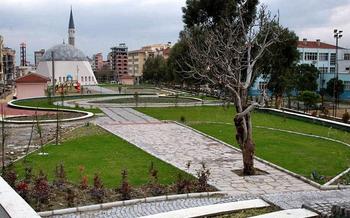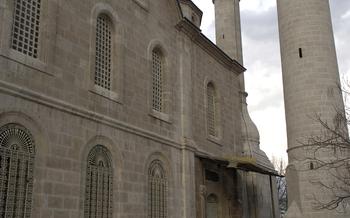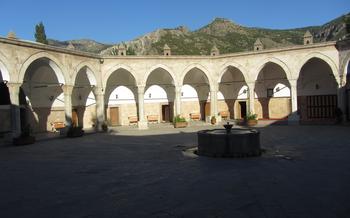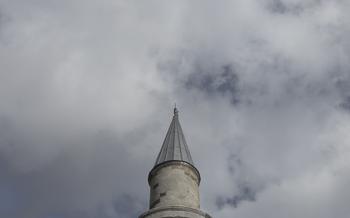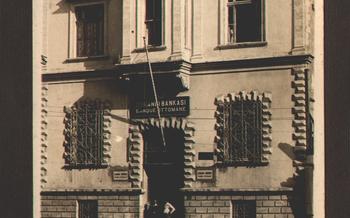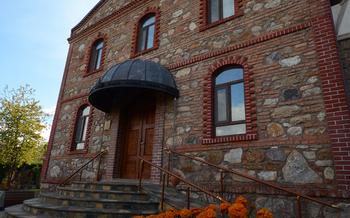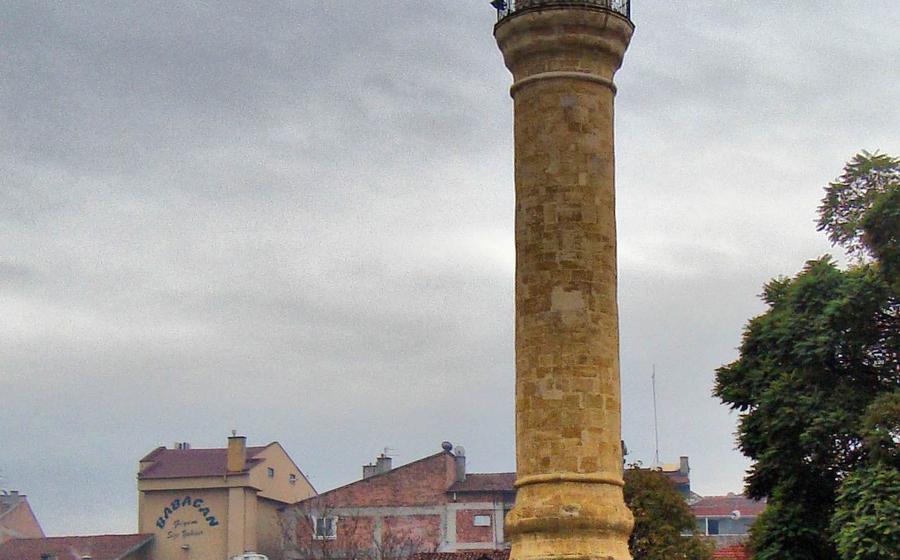
Iskilip Atıf Hodja Madrasa a historic educational institution
- The Iskilip Atıf Hoca Madrasah: A Journey Through History
- Unveiling the Architectural Masterpiece
- Exploring the Legacy of Atıf Hoca
- A Center of Islamic Scholarship
- Witnessing the Transformation
- Stepping Inside the Madrasah
- The Heart of the Madrasah: The Prayer Hall
- The Courtyard: A Place of Contemplation
- The Library: A Treasure Trove of Knowledge
- The Legacy of the Madrasah in Çorum
- Visiting the Iskilip Atıf Hoca Madrasah: Practical Information
- Unforgettable Experiences at the Madrasah
- Nearby Attractions and Activities
- Photography Tips for Capturing the Madrasah's Beauty
- Insider Tip: Unveiling Hidden Treasures
The Iskilip Atıf Hoca Madrasah: A Journey Through History
Nestled in the heart of Çorum, Turkey, stands the Iskilip Atıf Hoca Madrasah, a testament to the rich history and enduring legacy of Islamic education. Founded in the 15th century by the renowned scholar and spiritual leader Atıf Hoca, this architectural masterpiece has played a pivotal role in shaping the cultural and intellectual landscape of the region.
With its unique blend of Seljuk and Ottoman architectural styles, the madrasah stands as a symbol of Çorum's rich heritage. Its intricate carvings, tilework, and mesmerizing central courtyard with a fountain create a captivating ambiance that transports visitors back in time.
Beyond its architectural splendor, the Iskilip Atıf Hoca Madrasah holds immense historical significance. As a center of Islamic scholarship, it nurtured generations of scholars and contributed to the development of Çorum as a hub of learning. Its legacy continues to inspire and educate, serving as a reminder of the enduring power of knowledge and faith.
Preservation efforts have ensured that the madrasah's historical integrity remains intact. Restoration projects have carefully restored its original features, preserving its architectural beauty for future generations to appreciate. Today, the Iskilip Atıf Hoca Madrasah stands as a living testament to the enduring spirit of Islamic education and the rich cultural heritage of Çorum.
Unveiling the Architectural Masterpiece
The Iskilip Atıf Hoca Madrasah stands as a testament to the fusion of Seljuk and Ottoman architectural styles. Its facade, adorned with intricate carvings and tilework, captivates the eye with its geometric patterns and vibrant colors. The central courtyard, a haven of tranquility, features a mesmerizing fountain that echoes the soothing sounds of water. Inside, the prayer hall showcases stunning calligraphy and artwork, creating a spiritual ambiance that invites contemplation. Each architectural element of the madrasah harmoniously blends to create a masterpiece that embodies the rich history and cultural heritage of Çorum.
Exploring the Legacy of Atıf Hoca
Atıf Hoca, a renowned scholar and spiritual leader of the 15th century, played a pivotal role in shaping the intellectual and spiritual landscape of Çorum. His teachings and influence extended far beyond the walls of the madrasah, leaving an indelible mark on Islamic thought and scholarship.
Atıf Hoca's profound knowledge of Islamic law, theology, and philosophy attracted students from across the region, eager to learn from his wisdom. He was known for his ability to simplify complex concepts, making them accessible to students of all levels. His teachings emphasized the importance of compassion, justice, and ethical conduct, inspiring his students to become not only learned scholars but also virtuous individuals.
Beyond his role as an educator, Atıf Hoca was a respected spiritual leader, guiding his followers on the path of self-discovery and spiritual enlightenment. His teachings emphasized the importance of inner purification, self-discipline, and devotion to God. Through his guidance, many found solace, meaning, and purpose in their lives.
Anecdotes and stories about Atıf Hoca's wisdom and teachings abound in Çorum. One tale recounts a time when a group of travelers sought his counsel on a matter of great importance. Atıf Hoca listened patiently to their concerns and then responded with a simple parable that illuminated the path forward. The travelers left feeling enlightened and grateful for his guidance.
Atıf Hoca's legacy extends beyond the madrasah walls, as his teachings continue to inspire and guide generations of Muslims in Çorum and beyond. His contributions to Islamic scholarship and spirituality have left an enduring mark on the city's cultural and intellectual heritage.
A Center of Islamic Scholarship
The Iskilip Atıf Hoca Madrasah served as a prominent center of Islamic scholarship, nurturing a vibrant intellectual environment that attracted students from across the region. Renowned scholars and teachers imparted knowledge in various Islamic disciplines, including theology, law, philosophy, and the Quranic sciences. The madrasah's curriculum was designed to provide students with a comprehensive understanding of Islamic teachings and prepare them for roles as religious leaders, scholars, and judges.
Notable alumni of the madrasah went on to make significant contributions to Islamic scholarship and education. Among them was Atıf Hoca's own son, Mehmed Efendi, who became a renowned scholar and teacher in his own right. Other notable alumni include Mustafa Efendi, who served as the chief judge of Çorum, and Ahmed Efendi, who became a prominent figure in the Ottoman bureaucracy.
The madrasah's library played a crucial role in preserving and disseminating Islamic knowledge. It housed a rich collection of valuable manuscripts, books, and texts on various Islamic subjects, including Quranic exegesis, hadith, law, and mysticism. Rare and valuable editions of the Quran and other religious texts were carefully preserved in the library, making it a treasure trove of Islamic heritage.
In addition to its educational role, the madrasah also served as a center for religious guidance and spiritual development. Students and scholars engaged in regular prayers, attended lectures and discussions on Islamic topics, and participated in spiritual retreats and meditation sessions. The madrasah's serene and contemplative atmosphere fostered a deep sense of spirituality and connection with the divine.
Witnessing the Transformation
Over the centuries, the Iskilip Atıf Hoca Madrasah has undergone a remarkable transformation, adapting to the changing needs and circumstances of Çorum. Initially serving as a vibrant center of Islamic education, the madrasah gradually evolved into a museum showcasing the rich artistic heritage of the region. This transition reflects the dynamic nature of Islamic institutions and their ability to adapt to changing societal landscapes.
In the early 20th century, as the Ottoman Empire transitioned into the modern era, the madrasah faced challenges to its traditional role as an educational institution. The introduction of secular education systems and the changing educational landscape led to a decline in the number of students seeking religious instruction at the madrasah. Recognizing the need for preservation and adaptation, local authorities and cultural enthusiasts undertook a comprehensive restoration project to transform the madrasah into a museum.
The restoration efforts aimed to preserve the architectural integrity of the madrasah while adapting it to its new purpose. Careful attention was paid to restoring the intricate carvings, tilework, and calligraphy that adorned the facade and interiors. The central courtyard was revitalized, with the fountain restored to its former glory. The prayer hall, once a hub of religious instruction, was carefully preserved, showcasing its stunning artwork and calligraphy.
Today, the Iskilip Atıf Hoca Madrasah stands as a testament to the enduring legacy of Islamic architecture and education in Çorum. As a museum, it offers visitors a glimpse into the rich cultural and intellectual heritage of the region. Through its exhibits and displays, the madrasah educates visitors about the contributions of Atıf Hoca and the role of the madrasah in shaping the intellectual landscape of Çorum.
Stepping Inside the Madrasah
Entering the Iskilip Atıf Hoca Madrasah is like stepping back in time to an era of Islamic scholarship and devotion. The madrasah's layout is a testament to its educational purpose, with classrooms, dormitories, and a prayer hall arranged around a central courtyard. The architectural elements, such as arches, columns, and domes, create a sense of grandeur and symmetry.
Decorative features, including intricate tilework and calligraphy, adorn the walls and ceilings, adding to the aesthetic beauty of the madrasah. The atmosphere inside is one of tranquility and reverence, inviting visitors to contemplate and reflect on the teachings of Islam.
The classrooms, once filled with eager students seeking knowledge, now stand as silent witnesses to the madrasah's rich history. The dormitories, where students lived and shared their experiences, evoke a sense of camaraderie and community.
The prayer hall, the heart of the madrasah, exudes a spiritual aura. The qibla wall, adorned with a magnificent mihrab and minbar, guides the faithful towards Mecca. The domed ceiling, decorated with vibrant paintings and Quranic inscriptions, adds to the grandeur of the space.
Visitors can imagine the sound of prayers and recitations echoing through the hall, creating a symphony of devotion. The carpets and prayer rugs, intricately woven with Islamic motifs, invite visitors to sit, contemplate, and connect with the divine.
Stepping inside the Iskilip Atıf Hoca Madrasah is an immersive experience that transports visitors to a bygone era of Islamic learning and spirituality. It is a place where history, architecture, and faith intertwine, creating a sanctuary for reflection and inspiration.
The Heart of the Madrasah: The Prayer Hall
At the heart of the Iskilip Atıf Hoca Madrasah lies the awe-inspiring prayer hall, a sanctuary of devotion and spiritual tranquility. The qibla wall, adorned with an intricate mihrab and minbar, commands attention with its exquisite craftsmanship. The mihrab, a niche indicating the direction of prayer, features intricate carvings and colorful tilework, while the minbar, a stepped pulpit, displays fine woodwork and calligraphy.
The domed ceiling of the prayer hall is a masterpiece in itself, adorned with vibrant paintings and Quranic inscriptions. The harmonious blend of colors and patterns creates a sense of celestial grandeur, drawing the eyes upward in contemplation. Carpets and prayer rugs, adorned with traditional designs and motifs, add to the spiritual ambiance of the space, inviting worshippers to immerse themselves in prayer and reflection.
Whether attending prayers or simply observing religious ceremonies, visitors to the Iskilip Atıf Hoca Madrasah are granted a glimpse into the profound spirituality that permeates this sacred space. The prayer hall, with its exquisite artistry and serene atmosphere, stands as a testament to the enduring power of faith and devotion.
The Courtyard: A Place of Contemplation
The central courtyard of the Iskilip Atıf Hoca Madrasah serves as a tranquil oasis within the bustling city. Surrounded by elegant arches and columns, the courtyard offers a serene environment for students and scholars to gather, contemplate, and engage in meaningful conversations. Shaded areas and strategically placed water features create a refreshing ambiance, inviting visitors to pause and reflect.
In Islamic architecture, the courtyard holds a significant symbolic meaning. It represents the connection between the earthly realm and the heavens, a place where the divine and the human converge. The courtyard of the madrasah embodies this concept, fostering a sense of community and collective spirituality among its occupants.
As you step into the courtyard, you are immediately struck by its serene atmosphere. The sound of trickling water from the fountain blends harmoniously with the soft murmur of voices and the rustle of leaves in the gentle breeze. The intricate tilework adorning the walls and arches casts colorful reflections on the polished stone floor, creating a mesmerizing kaleidoscope of patterns.
The courtyard serves as a gathering space for students and scholars to engage in discussions, share knowledge, and seek guidance from their teachers. It is here that the madrasah's intellectual and spiritual legacy is nurtured and passed on from one generation to the next. Whether seeking solace, inspiration, or a moment of reflection, the courtyard of the Iskilip Atıf Hoca Madrasah offers a sanctuary for contemplation and spiritual growth.
The Library: A Treasure Trove of Knowledge
The Iskilip Atıf Hoca Madrasah houses a remarkable library, a treasure trove of knowledge that has been carefully preserved for centuries. This library contains a vast collection of valuable manuscripts, books, and texts on a wide range of Islamic subjects, including theology, philosophy, law, history, and literature. Among its most prized possessions are rare and valuable editions of the Quran and other religious texts, some dating back to the early centuries of Islam.
The library's collection is a testament to the madrasah's role as a center of Islamic scholarship and learning. It has played a crucial role in preserving Islamic heritage and ensuring the continuity of Islamic knowledge. In recent years, efforts have been made to digitize and preserve the collection for future generations, ensuring that these valuable texts remain accessible to scholars and researchers worldwide.
The Legacy of the Madrasah in Çorum
The Iskilip Atıf Hoca Madrasah has left an indelible mark on the cultural and intellectual landscape of Çorum. As a center of Islamic learning, it played a pivotal role in shaping the city's identity and attracting scholars and students from across the region. Its contributions to Islamic scholarship and education were far-reaching, nurturing a vibrant intellectual environment that continues to inspire and influence contemporary Islamic thought.
Beyond its educational impact, the madrasah also served as a beacon of spiritual guidance and community development in Çorum. Through its teachings and outreach, the madrasah fostered a sense of unity and belonging among the local population, promoting values of compassion, tolerance, and understanding. Stories and anecdotes passed down through generations reveal the profound impact the madrasah had on the lives of ordinary people, offering solace, guidance, and a path to spiritual fulfillment.
The legacy of the Iskilip Atıf Hoca Madrasah lives on in the cultural fabric of Çorum. Its architectural grandeur, rich history, and enduring influence continue to draw visitors from around the world, eager to experience the profound spiritual and intellectual heritage enshrined within its walls.
Visiting the Iskilip Atıf Hoca Madrasah: Practical Information
The Iskilip Atıf Hoca Madrasah is easily accessible, located in the heart of Çorum. It is open to visitors from 9 am to 5 pm daily, with a small admission fee. Guided tours are available for a deeper understanding of the madrasah's history and significance.
When visiting a religious site, it is essential to be respectful and observe proper etiquette. Modest dress is recommended, covering shoulders and knees. Visitors should refrain from talking loudly or engaging in disruptive behavior.
For photography enthusiasts, the madrasah offers a treasure trove of opportunities. The best time to capture its beauty is during the golden hours of sunrise and sunset, when the warm light casts a magical glow on the architecture. A tripod and wide-angle lens are recommended to capture the grandeur of the madrasah and its intricate details. Experiment with different angles and perspectives to create unique and captivating compositions.
Remember, the Iskilip Atıf Hoca Madrasah is an active place of worship, so be mindful of ongoing religious activities and avoid disturbing worshippers. With a little planning and respect, you can fully immerse yourself in the spiritual and architectural wonders of this historic madrasah.
Unforgettable Experiences at the Madrasah
Beyond its historical and architectural significance, the Iskilip Atıf Hodja Madrasah offers a range of unforgettable experiences that transport visitors to a bygone era. Indulge in a traditional Turkish coffee ceremony in the serene courtyard, where the aroma of freshly brewed coffee blends with the tranquility of the surroundings. Participate in a guided meditation or spiritual retreat, allowing the peaceful ambiance of the madrasah to soothe your mind and soul. Engage with local scholars or students to gain deeper insights into the madrasah's legacy and the teachings of Atıf Hoca. These unique experiences provide a profound connection to the history, culture, and spirituality that permeate this remarkable institution.
Nearby Attractions and Activities
Beyond the Iskilip Atıf Hoca Madrasah, Çorum offers a wealth of captivating attractions and activities to enrich your journey. Immerse yourself in the city's rich history by exploring the Çorum Kalesi (Çorum Castle). Perched atop a hill, this majestic fortress commands panoramic views of the city and the surrounding landscapes. Its ancient walls, towers, and gates whisper tales of bygone eras.
Delve into the depths of Çorum's Anatolian heritage at the Hitit Müzesi (Hitit Museum). This treasure trove of artifacts unveils the captivating story of the Hittites, an ancient civilization that once flourished in this region. Marvel at intricate cuneiform tablets, sculptures, and pottery that reveal their remarkable contributions to history.
Indulge in the vibrant tapestry of Çorum's culture at the Çorum Çarşısı (Çorum Bazaar). This bustling marketplace is a kaleidoscope of colors, aromas, and sounds. Haggle with friendly vendors for unique handicrafts, traditional textiles, and delectable local delicacies. Experience the warmth and hospitality of the Turkish people as you immerse yourself in the vibrant atmosphere of this lively souk.
Satisfy your taste buds with a culinary adventure in Çorum. Delight in the flavors of traditional Turkish cuisine at local restaurants. Savor succulent kebabs, aromatic stews, and freshly baked pide (Turkish flatbread). Treat yourself to the sweetness of Turkish delight, a confection that embodies the country's rich culinary heritage.
Photography Tips for Capturing the Madrasah's Beauty
To fully capture the grandeur and essence of the Iskilip Atıf Hoca Madrasah, consider the following photography tips:
-
Golden Hour Magic: Plan your visit during the golden hours, just after sunrise or before sunset, when the warm, diffused light enhances the architectural details and creates a magical atmosphere.
-
Camera Settings: Use a wide-angle lens to capture the sweeping facades and intricate carvings. Adjust your aperture for sharp focus on architectural elements and a shallow depth of field to blur the background.
-
Creative Angles: Experiment with different perspectives to showcase the madrasah's grandeur. Shoot from a low angle to emphasize its towering minarets or from above to capture the courtyard's serene beauty.
-
Storytelling Shots: Capture the essence of the madrasah through details that tell a story. Photograph students studying in the courtyard, visitors admiring the intricate tilework, or the play of light and shadow on the walls.
Insider Tip: Unveiling Hidden Treasures
Beyond the main attractions of the Iskilip Atıf Hoca Madrasah, there are hidden gems waiting to be discovered. Venture to the rooftop terrace to enjoy breathtaking panoramic views of Çorum and the surrounding landscapes. As you explore the madrasah, keep an eye out for hidden inscriptions and symbols that reveal its rich history. Engage with the local community to learn about hidden stories and traditions passed down through generations. Participate in special events or festivals held at the madrasah to immerse yourself in the vibrant cultural heritage of Çorum. These hidden treasures offer a deeper understanding of the madrasah's significance and provide a unique and enriching experience for visitors.
